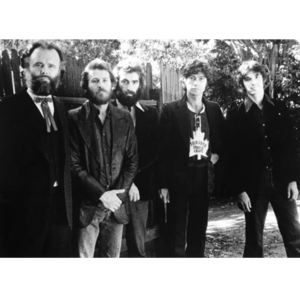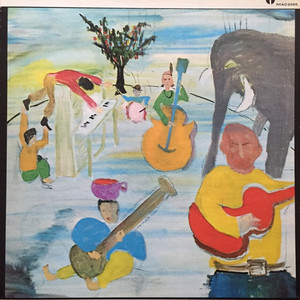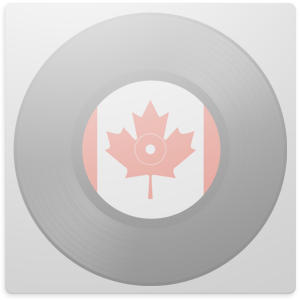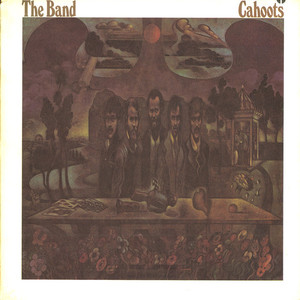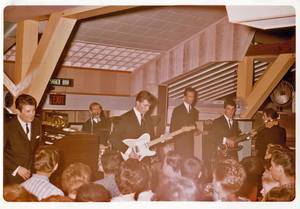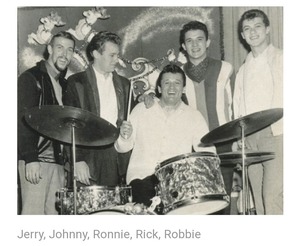Band
Websites:
https://theband.hiof.no/
Origin:
Toronto, Ontario, 🇨🇦 (Robbie Robertson); Stratford, Ontario, 🇨🇦 (Richard Manuel); Windsor, Ontario, 🇨🇦 (Garth Hudson); Simcoe, Ontario, 🇨🇦 (Rick Danko); Marvell, Arkansas, 🇺🇸 (Levon Helm)
Biography:
Robbie Robertson was the chief craftsman behind The Band’s music
Two things about Robbie Robertson: One, he was not self-effacing about his musical legacy; two, he had nothing at all to be modest about.
He played electric guitar – a Telecaster or a Stratocaster, usually – as if it were a thug’s jackknife, and wrote lyrics with a novelist’s sense of narrative and detail. He called the band he led the Band. They were pioneer figures of a genre, Americana. They are the greatest rock band Canada has ever produced, and they never would have happened without the songwriting and conceptual vision of Mr. Robertson, who died Wednesday at the age of 80.
The Band released its first album, Music From Big Pink, in 1968. It was a time when the world’s most illustrious rock musicians were more often than not British. It was literally called the British invasion, led by the Beatles. People called Eric Clapton “God.”
But a lot of those British musicians – including George Harrison and Mr. Clapton – wanted to be in the Band, with drummer Levon Helm and Canadians Rick Danko, Garth Hudson, Richard Manuel and Mr. Robertson, a Toronto-born former teenaged guitar phenom who spent summers with his mother’s family on the Six Nations of the Grand River reserve southwest of the city.
When Mr. Clapton showed up in upstate New York to jam with the Band, he was told flat out, “We don’t jam.” No, they wrote songs, and Mr. Robertson was the group’s chief craftsman.
The Band was originally known as the Hawks. During that period, in 1965, Bob Dylan picked Mr. Robertson and company to back him when he “went electric.” The Blowin’ in the Wind singer did not hire chumps.
Open this photo in gallery:
From the left: Rick Danko, Robbie Robertson, Levon Helm, Richard Manuel and Garth Hudson of The Band in London in 1971.
GIJSBERT HANEKROOT/GETTY IMAGES
Pete Townshend first heard Music From Big Pink on a powerful sound system in a house owned by Peter Tork of the Monkees in Los Angeles. “I realized I was listening to something ground-breaking,” the Who guitarist later recalled.
I spoke to Mr. Robertson in 2016, upon the release of the 50th anniversary reissue of Music From Big Pink. How did he feel about rock ‘n’ roll royalty bowing to him and the Band? He took it in stride.
“We knew we were musicians’ musicians,” he said. “We knew we were speaking to a lot of people who played music. We had been gathering, on the road. We were together for seven years before we made Music From Big Pink. We had paid our dues. When the record came out, we were kind of surprised. People were like: ‘Where the hell did this come from?’ It came from experience, honing your skills and trying to find subtleties as well as the obvious.”
Asked about superstars such as Mr. Dylan, Mr. Harrison and Mr. Clapton being blown away by what he and the Band were doing, Mr. Robertson said it wasn’t just them who were impressed.
“Those guys were the ones vocal about it. But there were tons of other musicians. They knew we were speaking a certain language. And if you got it, if you had been around the block, you would see it was touching a certain place in the soul.”
Touching a certain place in the soul – that gets to it. They did that in a variety of ways: the brotherly vocal harmonies, the old-timey publicity photographs by Elliot Landry and the mystique of crack musicians holed up in the mountains near Woodstock, N.Y., as if they were sepia-toned train robbers on the run.
The Band’s most enduring legacy, of course, are the songs, more often than not written by Mr. Robertson. The other group members sang beautifully, but the Band’s voice was Mr. Robertson’s, who with his lyrics mourned the lost American South (The Night They Drove Old Dixie Down), empathized with displaced people (Acadian Driftwood) and told a quasi-biblical story that sounded like something from another century (The Weight).
Although a Canadian, Mr. Robertson had the heart of Huckleberry Finn and viewed the South through a romantic lens. His single Somewhere Down the Crazy River, from his eponymous debut solo album in 1987, was languid, sultry and cinematic.
In his book Soul Mining, Daniel Lanois, who produced the album and that charting single, spoke about the song’s lust, magic, mystery and embrace of the blues: “It was all there in Somewhere Down the Crazy River,” he wrote.
The song was inspired by Mr. Robertson’s time spent in the South as a young musician. The first chapter of his 2016 memoir, Testimony, was dedicated to the same place and time. He was 16 years old, travelling from Toronto by train to Arkansas to audition for a job playing with Ronnie Hawkins and the Hawks.
“Stared out that train window into the darkness, till I near went blind,” he wrote. Mr. Robertson translated that sense of wonderment into his music.
At the age of 9, he had told his mother, who was Mohawk and Cayuga, that he wanted to be a storyteller when he grew up. According to Mr. Robertson, she smiled and said, “I think you will.”
-Brad Wheeler, Globe and Mail Aug 9, 2023
Robbie Robertson, 80, Dies; Canadian Songwriter Captured American Spirit
As the chief songwriter and guitarist for the Band, he offered a rustic vision of his adopted country that helped inspire the genre that came to be known as Americana.
Robbie Robertson, the chief composer and lead guitarist for the Band, whose work offered a rustic vision of America that seemed at once mythic and authentic, in the process helping to inspire the genre that came to be known as Americana, died on Wednesday in Los Angeles. He was 80.
His manager, Jared Levine, said he died after a long illness.
The songs that Mr. Robertson, a Canadian, wrote for the Band used enigmatic lyrics to evoke a hard and colorful America of yore, a feat coming from someone not born in the United States. With uncommon conviction, they conjured a wild place, often centered in the South, peopled by rough-hewed characters, from the defeated Confederate soldier in “The Night They Drove Old Dixie Down” to the tough union worker of “King Harvest Has Surely Come” to the shady creatures in “Life Is a Carnival.”
The music he matched to his passionate yarns mined the roots of every essential American genre, including folk, country, blues and gospel. Yet when his history-minded compositions first appeared on albums by the Band in the late 1960s, they felt vital as well as vintage.
“I wanted to write music that felt like it could’ve been written 50 years ago, tomorrow, yesterday — that had this lost-in-time quality,” Mr. Robertson said in a 1995 interview for the public television series “Shakespeares in the Alley.”
Speaking of the Band in the 2020 documentary “Once Were Brothers,” Bruce Springsteen said, “It’s like you’d never heard them before and like they’d always been there.”
In its day, the Band’s music also stood out by inverting the increasing volume and mania of psychedelic rock, and also by sidestepping its accent on youthful rebellion. “We just went completely left when everyone else went right,” Mr. Robertson said.
The ripple effect of that sound and image — unveiled on the Band’s first album, “Music From Big Pink,” released in 1968 — went wide on impact, landing the group on the cover of Time magazine in 1970 and inspiring a host of major artists to create their own homespun amalgams, from the Grateful Dead’s album “American Beauty” (1970) to Elton John’s “Tumbleweed Connection,” released the next year.
The Band’s music so affected Mr. Robertson’s fellow guitarist Eric Clapton that he lobbied for entry into their ranks. (The offer was politely declined.) A quarter-century later, the Band’s music provided a key template for the acts first labeled Americana, including Son Volt, Wilco and Lucinda Williams, as well as for their sonic heirs.
Audio Stories are Redefining Pleasure for Women
Though Mr. Robertson dominated the Band’s writing credits, he frequently emphasized the importance of all five members. “Everybody did something that raised the level of what we were doing to a stronger place,” he told The Guardian in 2019. “They’re all unique characters you could read about in a book,” he told Musician magazine in 1982.
A Southern Muse
While the texture of his playing was often flinty, his licks and leads were flush with feeling. In Mr. Helm, Mr. Robertson found a special muse, as well as a true link to the South; born in Arkansas, Mr. Helm was the only member of the Band not born in Canada.
“I know at the time that it seemed strange that somebody from Canada would be writing this Southern anthem,” Mr. Robertson told “Shakespeares in the Alley,” referring to “The Night They Drove Old Dixie Down,” which Mr. Helm sang. “It took somebody coming in the from the outside to really see these things.”
The lofty stature of the Band was further burnished by their participation in several seminal events in the history of Bob Dylan. They served as his backing group during the historic 1965-66 tour that found him “going electric,” to the horror of folk fundamentalists who booed his move away from his original acoustic style. “When people boo you night after night, it can affect your confidence,” Mr. Robertson told The Guardian. But, he added, “We didn’t budge. The more they booed, the louder we got.”
In “Once Were Brothers,” Mr. Dylan called the group “gallant knights” for sticking with him.
In the summer of 1967, the Band went to live near Mr. Dylan’s home in Woodstock, N.Y., and together they recorded a trove of important songs, some of which later leaked out in the form of the first significant bootleg record, nicknamed “The Great White Wonder.” Key songs from those sessions, mainly written by Mr. Dylan but augmented by pieces written by members of the Band, including Mr. Robertson, didn’t enjoy an official release until 1975, as the double album “The Basement Tapes.” It became a Top 10 hit and inspired the New York Times critic John Rockwell to call it “one of the greatest albums in the history of American popular music.”
In 1974, the Band reunited with Mr. Dylan, backing him on the album “Planet Waves,” which became a No. 1 Billboard hit, and then launching a tour that yielded the gold concert recording “Before the Flood.”
Two years later, the Band gave what at the time was called its final concert, held in San Francisco and billed as “The Last Waltz.” An all-star affair, it featured guest artists from Joni Mitchell and Van Morrison to Muddy Waters and Neil Young, as well as Mr. Dylan. A film of the show, released in 1978 and directed by Martin Scorsese, was lionized by Rolling Stone magazine in 2020 as “the greatest concert movie of all time.” The Band was inducted into the Rock & Roll Hall of Fame in 1994.
Some years after the group’s demise, in 1987, Mr. Robertson began a solo career with an album simply titled “Robbie Robertson.” In the decades that followed, he released four more solo albums, though only the first one went gold.
Most of his post-Band professional efforts were devoted to work in film, often in collaboration with Mr. Scorsese, as either a music producer or supervisor or as a composer of scores. The two worked together on noted films like “Raging Bull” and “Casino.” Mr. Robertson also served as a music producer or composer on scores of soundtracks for film and television projects, and even did some acting, co-starring with Jodie Foster and Gary Busey in the 1980 film “Carny.”
‘The Guitar Looks Pretty Cool’
Jamie Royal Robertson was born on July 5, 1943, in Toronto. His mother, Rosemary Dolly Chrysler, was a Mohawk who had been raised on the Six Nations Reserve near Toronto. The man whom he believed to be his father and who raised him until he was in his early teens, James Robertson, was a factory worker.
When he was a child, his mother often took him to the Six Nations Reserve where, Mr. Robertson told The Guardian, “it seemed to me that everyone played a musical instrument or sang or danced. I thought, ‘I’ve got to get into this club. I said, ‘I think the guitar looks pretty cool.’”
His mother bought him one.
“Rock ‘n’ roll suddenly hit me when I was 13 years old,” he told Classic Rock magazine in 2019. “That was it for me. Within weeks I was in my first band.”
Around that time his parents separated, and his mother told him that his biological father was a Jewish professional gambler named Alexander David Klegerman, who had been killed in a hit-and-run accident before she met James Robertson. In his memoir, “Testimony” (2016), Mr. Robertson wryly commented on his Indian and Jewish heritage.
“You could say I’m an expert when it comes to persecution,” he wrote.
His first band, Little Caesar and the Consuls, performed covers of the current hits. A group he joined three years later, in 1959, the Suedes, got a crucial break when they were seen by the Arkansas-based rockabilly star Ronnie Hawkins.
Mr. Hawkins saw enough in Mr. Robertson to write two songs with him, which he recorded, and he later invited the teenage guitarist to join his band, the Hawks, initially on bass. The Hawks also included Levon Helm on drums; by 1961, the other future members of the Band were also in the fold. They toured with Mr. Hawkins for two more years and recorded for Roulette Records. By 1964, they had gone off on their own as Levon and the Hawks.
Enter Bob Dylan
That group recorded a few singles for Atco, all written by Mr. Robertson, and in 1965 he was contacted by Mr. Dylan’s management and invited to be part of his backing group. While he initially refused, he did perform with Mr. Dylan in New York and Los Angeles, bringing along Mr. Helm for those gigs. At Mr. Robertson’s insistence, Mr. Dylan wound up hiring most of the other future members of the Band for the full tour.
He also invited Mr. Robertson to perform on a session in 1966 for his album “Blonde on Blonde.” The next year, he asked the Hawks to move to his new base in the Woodstock area, and they rented a house in nearby Saugerties that was later known as Big Pink. It was there that they recorded the music later released as “The Basement Tapes” as well as that which became “Music from Big Pink.”
“It was like a clubhouse where we could shut out the outside world,” Mr. Robertson wrote in his memoir. “It was my belief something magical would happen. And some true magic did happen.”
When “Music From Big Pink” was released in the summer of 1968, it boasted seminal songs written by Mr. Robertson like “The Weight” and “Chest Fever,” along with strong pieces composed by other members of the Band and by Mr. Dylan. “This album was recorded in approximately two weeks,” another close Dylan associate, Al Kooper, wrote in a review in Rolling Stone. “There are people who will work their lives away in vain and not touch it.”
For the Band’s follow-up album, “The Band,” released in 1969, Mr. Robertson either wrote or co-wrote every song, including some of his most enduring creations, among them “Up On Cripple Creek,” “Rag Mama Rag,” and “The Night They Drove Old Dixie Down,” which became a Top Five Billboard hit in a version recorded by Joan Baez. The album reached No. 9 on the magazine’s chart.
The Band’s next effort, “Stage Fright,” released in 1971, shot even higher, peaking at No. 5, buoyed by Robertson compositions like the title track and “The Shape I’m In.” Those songs, like many on the album, expressed deep anxiety and doubt, a theme that carried over to “Cahoots,” released in 1972. And while that album broke Billboard’s Top 20, it wasn’t as rapturously received as its predecessors.
A collection of blues and R&B covers, “Moondog Matinee,” was released in 1973, and Mr. Robertson’s muse fully returned in 1975 on the album “Northern Lights — Southern Cross,” which included “Acadian Driftwood,” his first composition with a Canadian theme. The original group’s final release, “Islands” (1977), consisted of leftover pieces and was issued mainly to fulfill the group’s contract with its label, Capitol Records.
The same year as “The Last Waltz,” Mr. Robertson produced a Top Five platinum album for Neil Diamond, “Beautiful Noise,” and a double live album by Mr. Diamond, “Live at the Greek,” which made Billboard’s Top Ten and sold more than two million copies.
Mr. Robertson told Musician magazine that he broke up the Band because “we had done it for 16 years and there was really nothing else to learn from it.” Another strong factor was Mr. Robertson’s frustration over hard drug use by most of the other members.
Without Mr. Robertson, the other members of the Band released three albums in the 1990s; the last, “Jubilation” in 1998, was without Mr. Manuel, who had died by suicide 12 years earlier at 40. Mr. Danko died of heart failure in 1999 at 56, Mr. Helm of throat cancer in 2012 at 71.
Over the years, other members of the Band accused Mr. Robertson of taking more songwriting credits than he deserved. To them, it was a cooperative effort, with the other members adding important arrangements and contributing elements that helped define the essential character of the recordings. Mr. Helm was particularly vociferous in his condemnation, amplified by his furious 1993 memoir, “This Wheel’s on Fire.”
In his own memoir, Mr. Robertson wrote of Mr. Helm, “it was like some demon had crawled into my friend’s soul and pushed a crazy, angry button.”
Mr. Robertson’s final solo album appeared in 2019 with a title, “Sinematic,” which underscored his devotion to film work in the last four decades of his life. He recently completed the score for his 14th film project, Mr. Scorsese’s “Killers of the Flower Moon,” which is to be released this fall.
Mr. Robertson is survived by his wife, Janet; his children, Alexandra, Sebastian and Delphine; and five grandchildren. His marriage to Dominique Bourgeois ended in divorce.
Marveling over where life had taken him, Mr. Robertson once told Classic Rock magazine: “People used to say to me, ‘You’re just a dreamer. You’re gonna end up working down the street, just like me.’ Part of that was crushing, and the other part is, ‘Oh yeah? I’m on a mission. I’m moving on. And if you look for me, there’s only going to be dust.’”
A correction was made on Aug. 9, 2023: An earlier version of this obituary misstated the name of Mr. Robertson’s first band. It was Little Caesar and the Consuls, not Little Ceasar and the Consults.
A correction was made on Aug. 10, 2023: An earlier version of this obituary misstated the location of the house, later known as Big Pink, where the members of the Band moved in 1967. It is in Saugerties, N.Y., not Woodstock.
Jim Farber, NT Times, Aug 9, 2023
